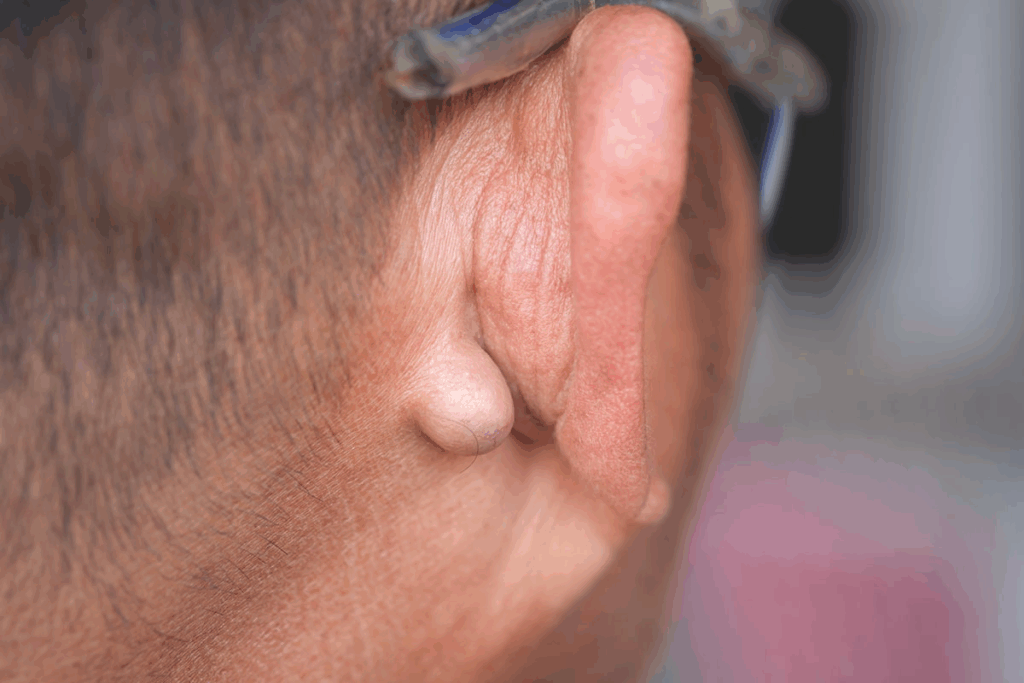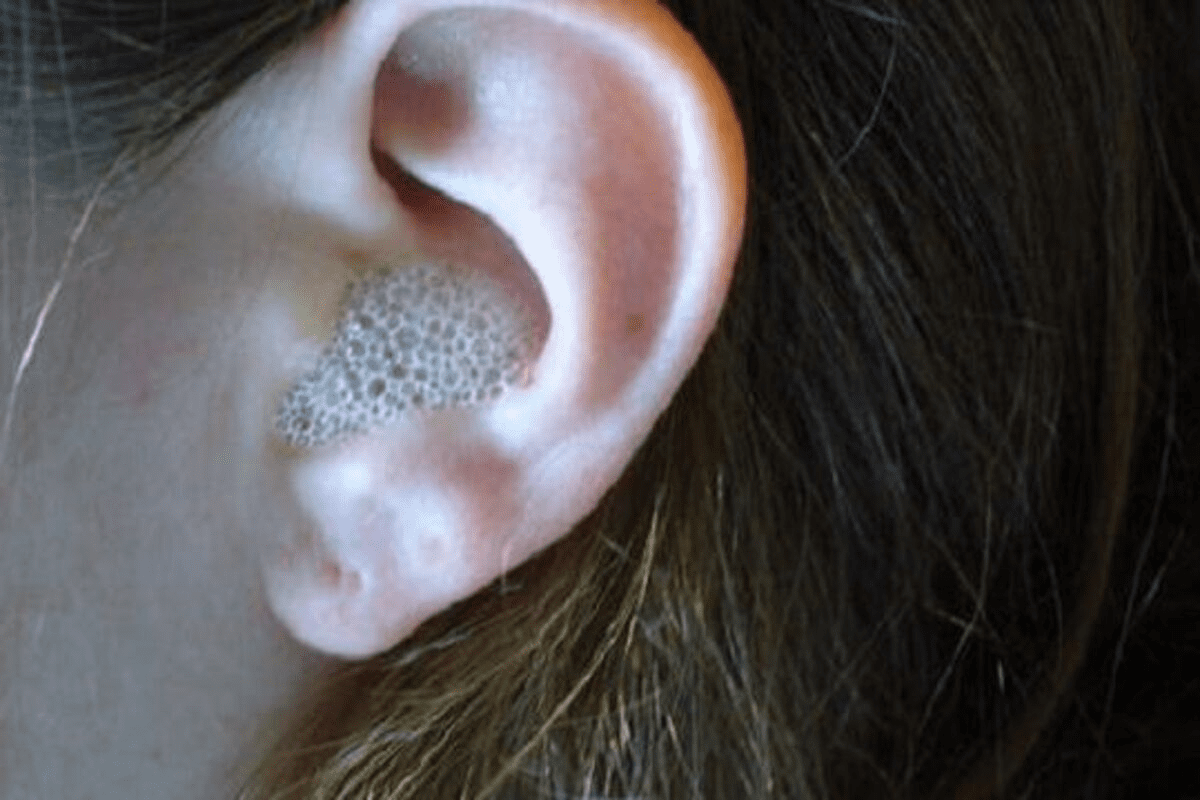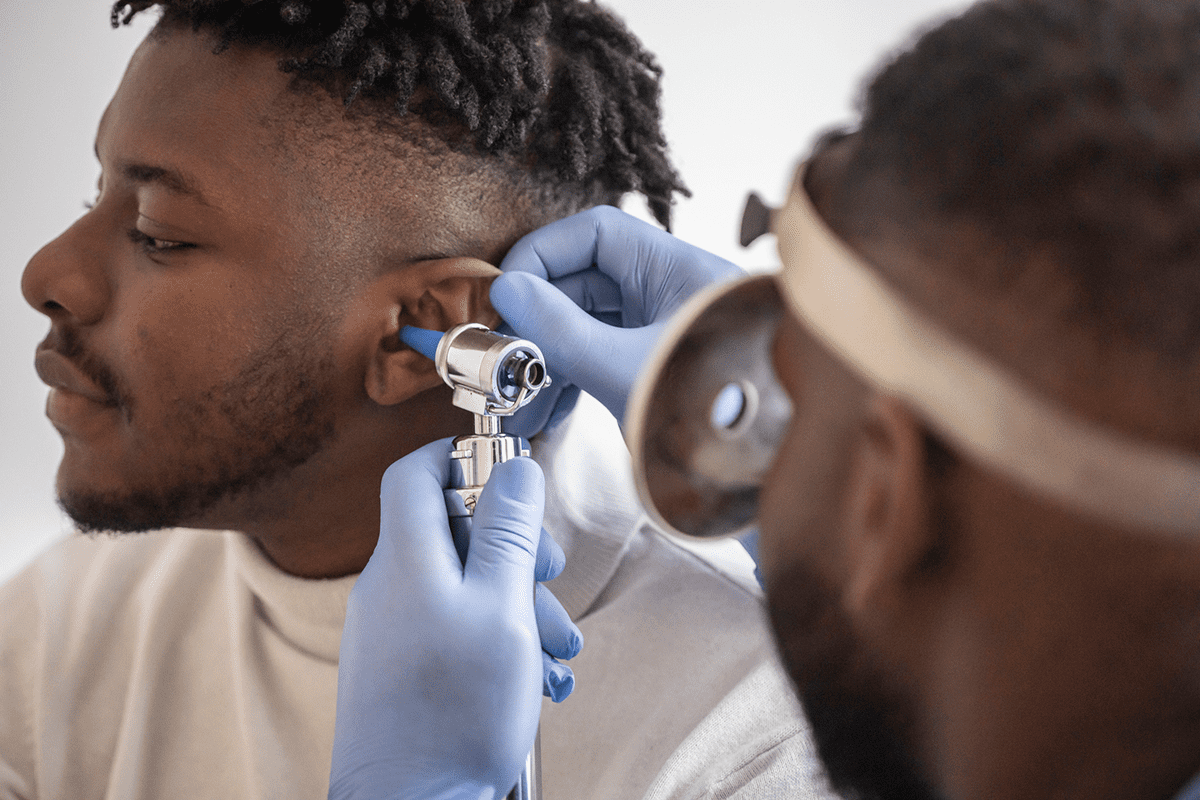
Discovering a lump behind your ear can be unsettling. But knowing its possible causes is the first step to feeling better. Lumps in this area can be due to many things, from minor infections to serious conditions.
Swollen lymph nodes are a common cause. They can be caused by infections, skin issues, or the body’s immune response. While many lumps go away on their own, some need a doctor’s check to rule out serious problems like mastoiditis or infections.
It’s key to understand the symptoms and get medical help if needed. This ensures you get the right diagnosis and treatment.
A lump below ear cancer related risk: Learn to distinguish between benign causes (swollen lymph nodes from infection) and malignant causes.

Ear lumps are common and can show up in different spots behind the ear. They can feel soft or hard, be big or small, and hurt or not hurt at all. Knowing what these lumps look like is key to figuring out why they’re there.
Lumps can pop up anywhere from the top of the ear to the earlobe. They might be right behind the earlobe or closer to the mastoid bone. Where the lump is can hint at what’s causing it. For example, a lump near the mastoid bone could mean mastoiditis, a serious infection.
Not every lump behind the ear is a worry. Some are harmless and don’t need a doctor’s visit. Normal lumps are usually small, don’t hurt, and stay the same. But, abnormal lumps might mean there’s something serious going on. These lumps can hurt, grow, or come with other signs like fever or swelling.
Watching any lump behind the ear is important. If it changes or comes with other symptoms, see a doctor. They can check it out and tell you what to do next.

Swollen lymph nodes are often the reason for lumps behind the ear. They can be caused by infections or inflammatory conditions. We’ll look at how lymph nodes work in our immune system and why they swell.
Lymph nodes are small, bean-shaped parts of our lymphatic system. They play a key role in fighting off infections. You can find them in the neck, armpits, and groin.
These nodes act as filters. They trap harmful pathogens like bacteria and viruses. Then, they help activate our immune system to fight off the infection.
Lymph nodes swell when they’re fighting an infection or inflammation. This swelling means they’re working hard to protect us. It happens because more immune cells, like lymphocytes, are being made to fight the infection.
Common reasons for swollen lymph nodes include:
Swollen lymph nodes can feel tender and may come with symptoms like fever or sore throat. Their size can vary, and they might be soft or firm. Sometimes, the area around the swollen node may be red or warm.
To figure out why a lymph node is swollen, a doctor will do a physical exam and ask about your medical history. They might also do tests like imaging studies or a biopsy.
A lump behind the ear might mean you have an infection that needs a doctor. These lumps can come from the ear, throat, tonsils, or skin near the ear. It’s important to get them checked.
Otitis media and otitis externa are common causes of lumps. Otitis media is an infection in the middle ear. It can spread to the mastoid bone, causing a painful lump.
Otitis externa is an infection of the outer ear canal. It causes discomfort and discharge. It can also lead to swelling and lumps.
These infections are usually caused by bacteria or viruses. Symptoms include pain, fever, and a lump behind the ear. If you have these symptoms, see a doctor quickly.
Infections in the throat and tonsils can also cause lumps. Swelling of lymph nodes in the neck and behind the ear happens. This is because of infections like tonsillitis or pharyngitis.
Symptoms include a sore throat, trouble swallowing, and swollen lymph nodes. These infections are often caused by viruses or bacteria. Treatment depends on the cause.
Skin infections near the ear can also cause lumps. Bacterial or fungal infections can lead to swelling and abscesses. For example, folliculitis, an infection of the hair follicles, can cause painful lumps.
Keep the area clean and see a doctor if it doesn’t get better. Skin infections can be a sign of something more serious.
The mastoid bone is behind the ear and can get a serious infection called mastoiditis. This usually happens when ear infections are not treated well. Knowing about mastoiditis helps us spot its signs and get help fast.
The mastoid bone is in the skull and has air spaces linked to the middle ear. An infection from the middle ear can spread to the mastoid bone, causing mastoiditis. This bone is key to the ear’s structure and is near nerves and blood vessels.
Spotting mastoiditis symptoms early is key for treatment. Common signs include:
These signs can change in how bad they are and can come on fast. If you or your child has these symptoms, see a doctor, and if there’s been an ear infection recently.
Kids get mastoiditis more than adults, mainly those under 7. Kids’ immune systems are growing, and their Eustachian tubes are shorter and more horizontal. This makes it easier for infections to spread. Kids with mastoiditis might also seem tired, irritable, and not want to eat.
“Mastoiditis is a serious condition that requires prompt treatment to prevent complications. In children, it’s important to watch for signs of mastoiditis after an ear infection.”
Treating mastoiditis usually means using antibiotics and sometimes surgery. The main goal is to get rid of the infection and avoid more problems.
Treatment Approach | Description |
Antibiotics | Intravenous antibiotics are given to fight the infection well. |
Surgical Drainage | Sometimes, surgery is needed to remove infected tissue and pus from the mastoid bone. |
Myringotomy | A surgical incision in the eardrum may be done to drain the middle ear. |
Quick treatment can greatly help those with mastoiditis. We stress the need to see a doctor if symptoms don’t get better or get worse.
A lump behind the ear can be a sign of viral infections. These infections make lymph nodes swell. It’s important to know why this happens to help treat it.
Viral infections often cause lumps behind the ear because of swollen lymph nodes. Common viral infections include chickenpox, measles, mononucleosis, and cytomegalovirus. These infections make lymph nodes swell as the body fights off the virus.
Chickenpox and measles are contagious and can make lymph nodes swell. Chickenpox has an itchy rash and fever. Measles has a distinctive rash and respiratory symptoms. Both can cause lumps behind the ear as the body reacts to the infection.
Mononucleosis, or glandular fever, is caused by the Epstein-Barr virus. It makes lymph nodes swell, causes fever, and sore throat. Cytomegalovirus (CMV) also causes lymph node swelling, mainly in people with weak immune systems. Both can lead to lumps behind the ear.
Knowing the viral cause of a lump behind the ear is key to the right treatment. We’ll look at how to diagnose this in later sections.
Cancerous lumps behind the ear are serious. Knowing their signs is key for early detection. These lumps can signal parotid gland cancer, lymphoma, or leukemia. It’s important to understand these signs for timely medical care.
Cancerous lumps behind the ear are often hard, painless, and fixed. They differ from swollen lymph nodes or other growths. These lumps may grow slowly and not show other symptoms at first.
Parotid gland cancer affects the salivary gland near the ear. Symptoms include a lump, facial weakness, and trouble swallowing. Early treatment is key.
Lymphoma starts in lymph system cells. A lump behind the ear can be a sign, along with fever, night sweats, and weight loss.
Leukemia is a blood and bone marrow cancer. It can cause lymph node swelling, leading to lumps behind the ear.
Type of Cancer | Common Symptoms | Characteristics of Lumps |
Parotid Gland Cancer | Lump or swelling near the ear, facial weakness | Hard, fixed, potentially painful |
Lymphoma | Fever, night sweats, weight loss, swollen lymph nodes | Painless, rubbery, or firm |
Leukemia | Fatigue, weight loss, frequent infections, swollen lymph nodes | Variable, can be painless or tender |
See a doctor if you find a lump behind your ear. It’s hard, painless, and fixed. Early detection is vital for treatment and better outcomes.
Many people worry about lumps behind their ear. These can be caused by non-cancerous growths. Knowing what they are and how they work can help you feel better and know what to do next.
Lipomas are soft, movable, and painless tumors made of fat. They can appear behind the ear. Lipomas are generally harmless but might be removed for looks or if they hurt.
Other tumors like fibromas or osteomas can also show up. These are not cancer and grow slowly. It’s good to check with a doctor to make sure they’re okay.
Sebaceous cysts are common lumps behind the ear. They happen when the sebaceous glands get blocked. Sebaceous cysts are usually benign and can be taken out if they get infected or hurt.
Acne and other skin issues can also cause lumps. Acne can lead to inflamed lesions that are painful and look bad. Keeping the area clean and using the right skincare can help. Sometimes, you might need to see a doctor for severe acne.
Nodules can be from things like keratosis pilaris or rheumatoid nodules. These are usually not serious but might mean you need to see a doctor.
In short, while lumps behind the ear can worry you, many are not serious. Knowing what they are and how to treat them can make you feel better and help you take action.
Healthcare professionals use many ways to find out why there’s a lump behind the ear. They do a physical check, use imaging tests, take biopsies, and run blood tests. This helps figure out what’s causing the lump.
The first step is a detailed physical check. They look at the lump’s size, how tender it is, and if it can move. This helps them guess what might be causing it.
Next, imaging tests are key. Ultrasound and CT scans help see what the lump looks like and how it affects nearby tissues. These tests can tell if the lump is harmless or might be cancer.
Sometimes, a biopsy is needed. This means taking a piece of tissue from the lump for lab tests. The biopsy results can show if the lump is cancerous or not.
Blood tests are also important. They check for signs of infection or swelling. For example, a high white blood cell count might mean there’s an infection.
Diagnostic Method | Purpose | Potential Findings |
Physical Examination | Initial assessment of the lump | Size, tenderness, mobility |
Imaging Tests (Ultrasound, CT Scan) | Evaluate lump characteristics and impact on surrounding tissues | Benign vs. potentially cancerous |
Biopsy | Determine lump’s cause through tissue analysis | Benign or malignant |
Blood Tests | Identify signs of infection or inflammation | Elevated white blood cell count, other markers |
Knowing why a lump is there is key to finding the right treatment. We’ll look at different treatments based on the cause of the lump.
Lumps from infections need to be treated first. Antibiotics fight bacterial infections, and antiviral medications tackle viral ones.
Non-infectious lumps can come from many things, like growths or cysts. The treatment depends on the lump’s type and how it affects the person.
Sebaceous cysts usually need a small surgery to take out. Lipomas, being fatty tumors, might get removed if they’re a bother or for looks.
Condition | Typical Treatment |
Sebaceous Cyst | Surgical removal |
Lipoma | Surgical excision |
Benign Tumors | Monitoring or surgical removal |
If a lump is cancer, the treatment varies by cancer type and stage. Chemotherapy, radiation therapy, and surgery are common ways to treat it.
For example, parotid gland cancer might need surgery to take out the tumor and gland. Then, radiation might follow. Lymphoma treatment can be chemotherapy, radiation, or both, based on the type and stage.
It’s vital for patients to team up with their doctors to find the best treatment plan. This plan should fit their specific situation and needs.
Noticing a lump behind your ear can be worrying. We suggest seeing a doctor if you notice certain signs. A painful lump or a swollen lymph node might mean you have an infection or another issue.
Watch out for symptoms like fever, trouble swallowing, or a growing lump. These could mean a serious problem that needs quick attention. If you see any of these, it’s time to talk to a doctor.
Think about the lump’s look and any other symptoms you have. A doctor can check it out and tell you what’s going on. Getting help early can make you feel better and make sure you get the right treatment.
Lumps behind the ear can come from many things. This includes infections, swollen lymph nodes, and non-cancerous growths. Sometimes, they might even be a sign of something serious like cancer.
No, not all lumps are cancer. Many are from harmless conditions like infections or non-cancerous growths.
Mastoiditis shows as pain, swelling, and redness behind the ear. You might also have a fever and discharge from your ear. It’s a serious infection that needs quick medical help.
Yes, viral infections like chickenpox, measles, mononucleosis, and cytomegalovirus can cause swollen lymph nodes. This leads to lumps behind the ear.
Cancerous lumps are hard and don’t hurt. They can grow bigger over time. Cancers like parotid gland cancer, lymphoma, and leukemia can cause these lumps.
Doctors use a physical exam to start. They might also do CT or MRI scans, biopsies, and blood tests. These help figure out what’s causing the lump.
Treatment varies based on the cause. For infections, antibiotics might be used. Non-cancerous growths might need to be surgically removed. For cancer, treatments like surgery, chemotherapy, or radiation might be needed.
See a doctor if the lump hurts, grows, or if you have a fever. Or if you’re worried about the lump.
Yes, swollen lymph nodes can mean an infection. This could be from a virus or bacteria.
No, lipomas and sebaceous cysts are usually not cancer. But, it’s important to get them checked by a doctor to be sure.
Lymph nodes are key to the immune system. They filter lymph fluid, catch pathogens, and start immune responses.
MedlinePlus. (n.d.). Tonsillectomy – adult. Retrieved from https://medlineplus.gov/ency/article/002930.htm
Subscribe to our e-newsletter to stay informed about the latest innovations in the world of health and exclusive offers!
WhatsApp us